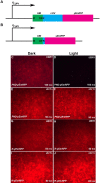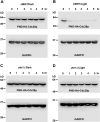Light-dependent N-end rule-mediated disruption of protein function in Saccharomyces cerevisiae and Drosophila melanogaster
- PMID: 33999957
- PMCID: PMC8158876
- DOI: 10.1371/journal.pgen.1009544
Light-dependent N-end rule-mediated disruption of protein function in Saccharomyces cerevisiae and Drosophila melanogaster
Abstract
Here we describe the development and characterization of the photo-N-degron, a peptide tag that can be used in optogenetic studies of protein function in vivo. The photo-N-degron can be expressed as a genetic fusion to the amino termini of other proteins, where it undergoes a blue light-dependent conformational change that exposes a signal for the class of ubiquitin ligases, the N-recognins, which mediate the N-end rule mechanism of proteasomal degradation. We demonstrate that the photo-N-degron can be used to direct light-mediated degradation of proteins in Saccharomyces cerevisiae and Drosophila melanogaster with fine temporal control. In addition, we compare the effectiveness of the photo-N-degron with that of two other light-dependent degrons that have been developed in their abilities to mediate the loss of function of Cactus, a component of the dorsal-ventral patterning system in the Drosophila embryo. We find that like the photo-N-degron, the blue light-inducible degradation (B-LID) domain, a light-activated degron that must be placed at the carboxy terminus of targeted proteins, is also effective in eliciting light-dependent loss of Cactus function, as determined by embryonic dorsal-ventral patterning phenotypes. In contrast, another previously described photosensitive degron (psd), which also must be located at the carboxy terminus of associated proteins, has little effect on Cactus-dependent phenotypes in response to illumination of developing embryos. These and other observations indicate that care must be taken in the selection and application of light-dependent and other inducible degrons for use in studies of protein function in vivo, but importantly demonstrate that N- and C-terminal fusions to the photo-N-degron and the B-LID domain, respectively, support light-dependent degradation in vivo.
Conflict of interest statement
The authors have declared that no competing interests exist.
Figures










Similar articles
-
Controlling Protein Activity and Degradation Using Blue Light.Methods Mol Biol. 2016;1408:67-78. doi: 10.1007/978-1-4939-3512-3_5. Methods Mol Biol. 2016. PMID: 26965116
-
Photo-sensitive degron variants for tuning protein stability by light.BMC Syst Biol. 2014 Nov 18;8:128. doi: 10.1186/s12918-014-0128-9. BMC Syst Biol. 2014. PMID: 25403319 Free PMC article.
-
Protein quality control degron-containing substrates are differentially targeted in the cytoplasm and nucleus by ubiquitin ligases.Genetics. 2021 Mar 3;217(1):1-19. doi: 10.1093/genetics/iyaa031. Genetics. 2021. PMID: 33683364 Free PMC article.
-
Tying up loose ends: the N-degron and C-degron pathways of protein degradation.Biochem Soc Trans. 2020 Aug 28;48(4):1557-1567. doi: 10.1042/BST20191094. Biochem Soc Trans. 2020. PMID: 32627813 Free PMC article. Review.
-
Conditional Degrons for Controlling Protein Expression at the Protein Level.Annu Rev Genet. 2017 Nov 27;51:83-102. doi: 10.1146/annurev-genet-120116-024656. Annu Rev Genet. 2017. PMID: 29178817 Review.
Cited by
-
Genetic manipulation for the non-model protozoan Eimeria: Advancements, challenges, and future perspective.iScience. 2025 Feb 17;28(3):112060. doi: 10.1016/j.isci.2025.112060. eCollection 2025 Mar 21. iScience. 2025. PMID: 40109377 Free PMC article. Review.
-
Precise modulation of embryonic development through optogenetics.Genesis. 2022 Dec;60(10-12):e23505. doi: 10.1002/dvg.23505. Epub 2022 Dec 7. Genesis. 2022. PMID: 36478118 Free PMC article. Review.
-
BMP Signaling: Lighting up the Way for Embryonic Dorsoventral Patterning.Front Cell Dev Biol. 2021 Dec 23;9:799772. doi: 10.3389/fcell.2021.799772. eCollection 2021. Front Cell Dev Biol. 2021. PMID: 35036406 Free PMC article. Review.
-
Design and engineering of light-sensitive protein switches.Curr Opin Struct Biol. 2022 Jun;74:102377. doi: 10.1016/j.sbi.2022.102377. Epub 2022 Apr 20. Curr Opin Struct Biol. 2022. PMID: 35461160 Free PMC article. Review.
-
Opticool: Cutting-edge transgenic optical tools.PLoS Genet. 2024 Mar 22;20(3):e1011208. doi: 10.1371/journal.pgen.1011208. eCollection 2024 Mar. PLoS Genet. 2024. PMID: 38517915 Free PMC article. Review.
References
-
- Xu T, Rubin GM. Analysis of genetic mosaics in developing and adult Drosophila tissues. Development. 1993;117: 1223–1237. - PubMed
Publication types
MeSH terms
Substances
Grants and funding
LinkOut - more resources
Full Text Sources
Other Literature Sources
Molecular Biology Databases

